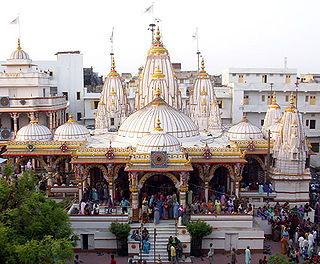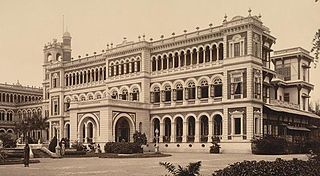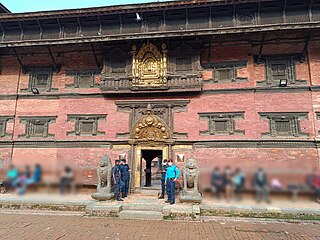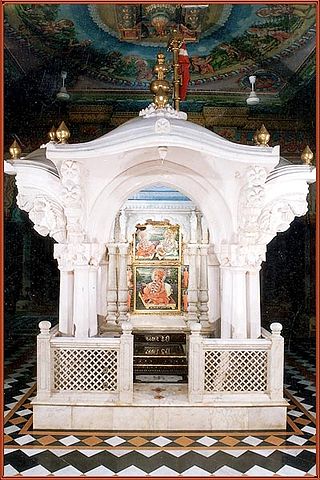
The Lahore Fort is a citadel in the city of Lahore in Punjab, Pakistan. The fortress is located at the northern end of Walled city of Lahore and spreads over an area greater than 20 hectares. It contains 21 notable monuments, some of which date to the era of Emperor Akbar. The Lahore Fort is notable for having been almost entirely rebuilt in the 17th century, when the Mughal Empire was at the height of its splendor and opulence.

Jamnagar is a city located on the western coast of India in the state of Gujarat of Saurashtra region. It is the administrative headquarters of the Jamnagar district and the fifth largest city in Gujarat. The city lies just to the south of the Gulf of Kutch, some 337 kilometres (209 mi) west of the state capital, Gandhinagar.

Gondal is a city of about 115,000 residents and a municipality of about 175,000 in the Rajkot district of the Indian state of Gujarat. Gondal Village was one of the eight first-class princely states of Kathiawar Agency, Bombay Presidency in British India. Ruled by a Hindu Rajput dynasty of the Jadeja.

Junagarh Fort is a fort in the city of Bikaner, Rajasthan, India. Raja Dhaj, Ror Kumar, ruled over the principality of Junagarh in the fifth century BC. The fort was originally called Chintamani and was renamed Junagarh or "Old Fort" in the early 20th century when the ruling family moved to Lalgarh Palace outside the fort limits. It is one of the few major forts in Rajasthan which is not built on a hilltop. The modern city of Bikaner has developed around the fort.

Samode Palace, Samode Haveli and Samode Bagh (Garden) are heritage monuments and structures built by the noble feudatory with the hereditary title of 'Maha Rawal' or 'Maha Saheb’ of the Amber and Jaipur principality in Rajasthan, India. All three have rich history of several hundred years and display a fusion of Mughal and Rajasthani art and architecture. They are now part of the Heritage group of hotels under the flagship name of "Samode" that are run by the hereditary owners of these structures. The Samode Palace is located 40 kilometres (25 mi) north of Jaipur city, the Samode Haveli is close to Jaipur (centrally located within city limits, 6 kilometres (3.7 mi) away from the city railway station) and the Samode Bagh or Garden, 4 kilometres (2.5 mi) from the palace which is also run as a luxury hotel.

The Amar Mahal Palace is a palace in Jammu, in the Indian erstwhile Kingdom of Jammu and Kashmir, India. The palace has now been converted into a museum. Commissioned by Maharaja Amar Singh, a Dogra king, the palace was built in the nineteenth century by a French architect on the lines of a French Chateau. The palace was donated to the Hari-Tara Charitable Trust by Karan Singh for use as a museum. It has many exhibits including a golden throne weighing 120kg, a Pahari miniature, Kangra miniature paintings, a library of 25,000 antique books, many rare art collections, and a large collection of portraits of the royal family.

Shree Swaminarayan Mandir Kalupur is the first Temple of the Swaminarayan Sampraday, a Hindu sect. It is located in Kalupur area of Ahmedabad, the largest city in Gujarat, India. It was built on the instructions of Swaminarayan, the founder of the sect.

Makarpura Palace is a royal palace of Gaekwads of the Baroda State, in present-day Vadodara, Gujarat, India. It was built by Maharaja Khende Rao in 1870, in the Italian style. It was used as summer residence and hunting resort by the Royal Family. The palace is now used as a training school called No.17 Tetra School by the Indian Air Force.

Bhagvatsinhji was the ruling Maharaja of the princely state of Gondal from 1869 till his death in 1944, upon which he was honoured with 11-gun salute. He was the only Maharaja of Gujarat to take a medical degree and other degrees.

City Palace, Udaipur is a palace complex situated in the city of Udaipur in the Indian state of Rajasthan. It was built over a period of nearly 400 years, with contributions from several rulers of the Mewar dynasty. Its construction began in 1553, started by Maharana Udai Singh II of the Sisodia Rajput family as he shifted his capital from the erstwhile Chittor to the newfound city of Udaipur. The palace is located on the east bank of Lake Pichola and has several palaces built within its complex.

The Ramnagar Fort is a fortification in Ramnagar, Varanasi, India. It is located near the Ganges on its eastern bank, opposite to the Tulsi Ghat. The sandstone structure was built in 1750 by Kashi Naresh Maharaja Balwant Singh. The current king and the resident of the fort is Anant Narayan Singh, who is also known as the Maharaja of Benares even though this royal title has been abolished since 1971.

The Jai Vilas Mahal, also known as the Jai Vilas Palace, is a nineteenth century palace in Gwalior, India. It was built in 1874 by Jayajirao Scindia, the Maharaja of Gwalior in the British Raj. While the major part of the palace is now the "Jiwajirao Scindia Museum" which opened to the public in 1964, a part of it is still the residence of some of his descendants.

The City Palace, Jaipur is a royal residence and former administrative headquarters of the rulers of the Jaipur State in Jaipur, Rajasthan. Construction started soon after the establishment of the city of Jaipur under the reign of Maharaja Sawai Jai Singh II, who moved his court to Jaipur from Amber, in 1727. Jaipur remained the capital of the kingdom until 1949—when it became the capital of the present-day Indian state of Rajasthan—with the City Palace functioning as the ceremonial and administrative seat of the Maharaja of Jaipur. The construction of the Palace was completed in 1732 and it was also the location of religious and cultural events, as well as a patron of arts, commerce, and industry. It was constructed according to the rules of vastushastra, combining elements of Mughal and Rajput architectural styles. It now houses the Maharaja Sawai Man Singh II Museum, and continues to be the home of the Jaipur royal family. The royal family has around 500 personal servants. The palace complex has several buildings, various courtyards, galleries, restaurants, and offices of the Museum Trust.The MSMS II Museum Trust is headed by chairperson Rajamata Padmini Devi of Jaipur. Princess Diya Kumari runs the Museum Trust, as its secretary and trustee. She also manages The Palace School and Maharaja Sawai Bhawani Singh School in Jaipur. She founded and runs the Princess Diya Kumari Foundation to empower underprivileged and underemployed women of Rajasthan. She is also an entrepreneur. In 2013, she was elected as Member of the Legislative Assembly of Rajasthan from the constituency of Sawai Madhopur.

The Prag Mahal is a 19th-century palace located next to the Aina Mahal in Bhuj, Kutch, Gujarat, India.

The Krishnapuram Palace is a palace and museum located in Kayamkulam near Alappuzha in Alappuzha district, Kerala in southwestern India. It was built in the 18th century by Anizham Thirunal Marthanda Varma, the Travancore kingdom. It is built in the architectural style of Kerala with gabled roof, narrow corridor and dormer windows, near the Krishnaswamy Temple at Krishnapuram.

Patan Durbar Square is situated at the centre of the city of Lalitpur in Nepal. It is one of the three Durbar Squares in the Kathmandu Valley, all of which are UNESCO World Heritage Sites. One of its attractions is the medieval royal palace where the Malla Kings of Lalitpur resided.

The Akshar Deri is a major site of pilgrimage in the Swaminarayan Sampradaya and is located in the rang mandap of the BAPS Swaminarayan temple in Gondal, India. The structure marks the cremation site and serves as a memorial to Gunatitanand Swami. An event was held to commemorate 150 years of the structure in Gondal, the structure as well as the site was renovated to bring it to modern standards.
The Riverside Palace is located in Gondal, India.
The Huzoor Palace, currently the residence of the royal family, is located in Gondal, India. Its annex, or wing, is known as the Orchard Palace.
Jethwa dynasty was a dynasty that ruled over present day Gujarat region of India from 7th century AD till middle of 20th century, when India became independent. It was a Rajput dynasty ruled by Jethwa clan of Rajputs.




















